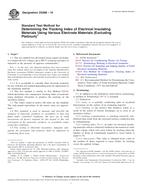Potřebujeme váš souhlas k využití jednotlivých dat, aby se vám mimo jiné mohly ukazovat informace týkající se vašich zájmů. Souhlas udělíte kliknutím na tlačítko „OK“.
ASTM D5288-10
Standard Test Method for Determining the Tracking Index of Electrical Insulating Materials Using Various Electrode Materials (Excluding Platinum)
Automaticky přeložený název:
Standardní zkušební metodu pro stanovení Tracking Index Elektroizolační materiály s použitím různých materiálů elektrod ( kromě Platinum )
NORMA vydána dne 15.1.2010
Informace o normě:
Označení normy: ASTM D5288-10
Poznámka: NEPLATNÁ
Datum vydání normy: 15.1.2010
Kód zboží: NS-30594
Počet stran: 5
Přibližná hmotnost: 15 g (0.03 liber)
Země: Americká technická norma
Kategorie: Technické normy ASTM
Anotace textu normy ASTM D5288-10 :
Keywords:
copper electrodes, comparative tracking index, CTI, TI, TI-Cu, track, tracking, tracking, contamination, tracking index, tracking resistance, Comparative tracking index (CTI), Copper electrodes, CTI-CU, Tracking, contamination, Tracking systems, Track resistance--electrical insulating materials, ICS Number Code 29.035.01 (Insulating materials in general)
Doplňující informace
| Significance and Use | ||||||||||
|
Electrical equipment has the potential to fail as a result of electrical tracking of insulating material that is exposed to various contaminating environments and surface conditions. A number of ASTM and other tests have been designed to quantify behavior of materials, especially at relatively high voltages. This method is an accelerated test which at relatively low test voltages, provides a comparison of the performance of insulating materials under wet and contaminated conditions. The Tracking Index—Copper Electrodes test is not related directly to the suitable operating voltage in service. When organic electrical insulating materials are subjected to conduction currents between electrodes on their surfaces, many minute tree-like carbonaceous paths or tracks are developed near the electrodes. These tracks are oriented randomly, but generally propagate between the electrodes under the influence of the applied potential difference. Eventually a series of tracks spans the electrode gap, and failure occurs by shorting of the electrodes. As in other tracking test methods, for example, IEC 112 and Test Method D3638, this test method specifies test procedures that are intended to promote the formation of surface discharges which will produce carbon tracks in a reproducible manner. Since these conditions rarely reproduce the actual conditions encountered in service, the results of tracking tests cannot be used to infer either direct or relative service behavior of a material in a specific design application. Tracking tests can be used for screening purposes only. Suitability is verified through testing of the material in actual end use or under conditions that closely simulate actual end use. The use of copper electrodes in this type of test was developed at the University of Cincinnati, NEMA laboratory. It is felt by the members of the Industrial Laminates Section of NEMA that using copper electrodes gives a more realistic value for a tracking index, related to the resin system used to reinforce the substrate of a laminate. In general, tracking tests made with copper electrodes tend to give lower values than platinum electrodes in the same type of test. It is a fact that copper is more widely used than platinum for electrical conductors. |
||||||||||
| 1. Scope | ||||||||||
|
1.1 This test method was developed using copper electrodes to evaluate the low-voltage (up to 600 V) tracking resistance of materials in the presence of aqueous contaminants. Note 1—At this time, only industrial laminates have been examined using this method which was developed at the National Manufacturers Electrical Association (NEMA) laboratory located at the University of Cincinnati. It was found that a closer end point (less scatter) was obtained than with platinum electrodes, and materials tested tended to be ranked by resin system. 1.1.1 It is acceptable to consider other electrode materials for use with this test method depending upon the application of the insulating material. 1.2 This test method is similar to Test Method D3638, which determines the comparative tracking index of materials using platinum electrodes to produce the tracking on the specimen surface. 1.3 The values stated in metric (SI) units are the standard. The inch-pound equivalents of the metric units are approximate. 1.4 This standard is used to measure and describe the response of materials, products, or assemblies to heat and flame under controlled conditions, but does not by itself incorporate all factors required for fire hazard or fire risk assessment of the materials, products, or assemblies under actual fire conditions. 1.5 Fire testing is inherently hazardous. Adequate safeguards for personnel and property shall be employed in conducting these tests. |
||||||||||
| 2. Referenced Documents | ||||||||||
|
Doporučujeme:
Aktualizace technických norem
Chcete mít jistotu, že používáte pouze platné technické normy?
Nabízíme Vám řešení, které Vám zajistí měsíční přehled o aktuálnosti norem, které používáte.
Chcete vědět více informací? Podívejte se na tuto stránku.




 Cookies
Cookies
